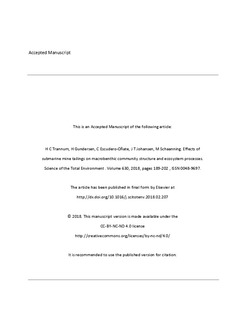| dc.contributor.author | Trannum, Hilde C | |
| dc.contributor.author | Gundersen, Hege | |
| dc.contributor.author | Escudero-Oñate, Carlos | |
| dc.contributor.author | Johansen, Joachim T | |
| dc.contributor.author | Schaanning, Morten T | |
| dc.date.accessioned | 2019-06-20T11:39:22Z | |
| dc.date.available | 2019-06-20T11:39:22Z | |
| dc.date.created | 2018-11-11T19:33:25Z | |
| dc.date.issued | 2018 | |
| dc.identifier.citation | Science of the Total Environment. 2018, 630, 189-202. | nb_NO |
| dc.identifier.issn | 0048-9697 | |
| dc.identifier.uri | http://hdl.handle.net/11250/2601545 | |
| dc.description | Embargo until 22 February 2020. | nb_NO |
| dc.description.abstract | A mesocosm experiment with intact benthic communities was conducted to evaluate the effects of mine tailings on benthic community structure and biogeochemical processes. Two types of tailings were supplied from process plants using flotation and flocculation chemicals, while a third type was absent of added chemicals. All tailings impacted the sediment community at thin layers, and through more mechanisms than merely hypersedimentation. In general, the strongest impact was observed in a very fine-grained tailings containing flotation chemicals. The second strongest occurred in tailings with no process chemicals. The tailings with flocculation chemicals initiated the weakest response. Fluxes of oxygen, nitrate and ammonium provided some indications on biodegradation of organic phases. Release of phosphate and silicate decreased with increasing layer thickness of all three tailings. A threshold level of 2 cm was identified both for faunal responses and for fluxes of phosphate and silicate. The particular impact mechanisms should receive more attention in future studies in order to minimize the environmental risk associated with tailings disposal. | nb_NO |
| dc.language.iso | eng | nb_NO |
| dc.publisher | Elsevier | nb_NO |
| dc.rights | Attribution-NonCommercial-NoDerivatives 4.0 Internasjonal | * |
| dc.rights.uri | http://creativecommons.org/licenses/by-nc-nd/4.0/deed.no | * |
| dc.title | Effects of submarine mine tailings on macrobenthic community structure and ecosystem processes | nb_NO |
| dc.type | Journal article | nb_NO |
| dc.type | Peer reviewed | nb_NO |
| dc.description.version | acceptedVersion | nb_NO |
| dc.source.pagenumber | 189-202 | nb_NO |
| dc.source.volume | 630 | nb_NO |
| dc.source.journal | Science of the Total Environment | nb_NO |
| dc.identifier.doi | 10.1016/j.scitotenv.2018.02.207 | |
| dc.identifier.cristin | 1629142 | |
| dc.relation.project | Norges forskningsråd: 236658 | nb_NO |
| cristin.unitcode | 7464,20,11,0 | |
| cristin.unitcode | 7464,30,21,0 | |
| cristin.unitcode | 7464,20,17,0 | |
| cristin.unitcode | 7464,20,19,0 | |
| cristin.unitname | Marin biologi | |
| cristin.unitname | Miljøkjemi | |
| cristin.unitname | Forskningsinfrastruktur | |
| cristin.unitname | Miljøgifter | |
| cristin.ispublished | true | |
| cristin.fulltext | postprint | |
| cristin.qualitycode | 2 | |

